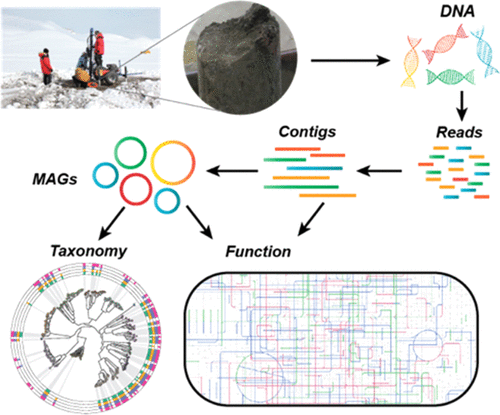当前位置:
X-MOL 学术
›
Environ. Sci. Technol.
›
论文详情
Our official English website, www.x-mol.net, welcomes your feedback! (Note: you will need to create a separate account there.)
Comparative Metagenomics of the Active Layer and Permafrost from Low-Carbon Soil in the Canadian High Arctic
Environmental Science & Technology ( IF 11.4 ) Pub Date : 2021-09-02 , DOI: 10.1021/acs.est.1c00802 Xiaofen Wu 1 , Archana Chauhan 1 , Alice C Layton 1 , Maggie C Y Lau Vetter 2 , Brandon T Stackhouse 2 , Daniel E Williams 1 , Lyle Whyte 3 , Susan M Pfiffner 1 , Tullis C Onstott 2 , Tatiana A Vishnivetskaya 1
Environmental Science & Technology ( IF 11.4 ) Pub Date : 2021-09-02 , DOI: 10.1021/acs.est.1c00802 Xiaofen Wu 1 , Archana Chauhan 1 , Alice C Layton 1 , Maggie C Y Lau Vetter 2 , Brandon T Stackhouse 2 , Daniel E Williams 1 , Lyle Whyte 3 , Susan M Pfiffner 1 , Tullis C Onstott 2 , Tatiana A Vishnivetskaya 1
Affiliation

|
Approximately 87% of the Arctic consists of low-organic carbon mineral soil, but knowledge of microbial activity in low-carbon permafrost (PF) and active layer soils remains limited. This study investigated the taxonomic composition and genetic potential of microbial communities at contrasting depths of the active layer (5, 35, and 65 cm below surface, bls) and PF (80 cm bls). We showed microbial communities in PF to be taxonomically and functionally different from those in the active layer. 16S rRNA gene sequence analysis revealed higher biodiversity in the active layer than in PF, and biodiversity decreased significantly with depth. The reconstructed 91 metagenome-assembled genomes showed that PF was dominated by heterotrophic, fermenting Bacteroidota using nitrite as their main electron acceptor. Prevalent microbes identified in the active layer belonged to bacterial taxa, gaining energy via aerobic respiration. Gene abundance in metagenomes revealed enrichment of genes encoding the plant-derived polysaccharide degradation and metabolism of nitrate and sulfate in PF, whereas genes encoding methane/ammonia oxidation, cold-shock protein, and two-component systems were generally more abundant in the active layer, particularly at 5 cm bls. The results of this study deepen our understanding of the low-carbon Arctic soil microbiome and improve prediction of the impacts of thawing PF.
中文翻译:

加拿大高北极低碳土壤活动层和多年冻土的比较宏基因组学
大约 87% 的北极由低有机碳矿质土壤组成,但对低碳永久冻土 (PF) 和活性层土壤中微生物活动的了解仍然有限。本研究调查了活动层(地表以下 5、35 和 65 厘米,bls)和 PF(80 cm bls)的不同深度处微生物群落的分类组成和遗传潜力。我们展示了 PF 中的微生物群落在分类和功能上与活性层中的微生物群落不同。16S rRNA基因序列分析显示,活动层生物多样性高于PF,生物多样性随深度显着下降。重建的 91 个宏基因组组装的基因组表明,PF 以异养、发酵拟杆菌为主,使用亚硝酸盐作为其主要电子受体。在活性层中鉴定出的流行微生物属于细菌类群,通过有氧呼吸获得能量。宏基因组中的基因丰度表明,PF 中编码植物源性多糖降解和硝酸盐和硫酸盐代谢的基因富集,而编码甲烷/氨氧化、冷休克蛋白和双组分系统的基因通常在活性层中更丰富,特别是在 5 厘米 bls 处。这项研究的结果加深了我们对低碳北极土壤微生物组的理解,并提高了对解冻 PF 影响的预测。而编码甲烷/氨氧化、冷激蛋白和双组分系统的基因通常在活性层中更丰富,尤其是在 5 cm bls 处。这项研究的结果加深了我们对低碳北极土壤微生物组的理解,并提高了对解冻 PF 影响的预测。而编码甲烷/氨氧化、冷激蛋白和双组分系统的基因通常在活性层中更丰富,尤其是在 5 cm bls 处。这项研究的结果加深了我们对低碳北极土壤微生物组的理解,并提高了对解冻 PF 影响的预测。
更新日期:2021-09-21
中文翻译:

加拿大高北极低碳土壤活动层和多年冻土的比较宏基因组学
大约 87% 的北极由低有机碳矿质土壤组成,但对低碳永久冻土 (PF) 和活性层土壤中微生物活动的了解仍然有限。本研究调查了活动层(地表以下 5、35 和 65 厘米,bls)和 PF(80 cm bls)的不同深度处微生物群落的分类组成和遗传潜力。我们展示了 PF 中的微生物群落在分类和功能上与活性层中的微生物群落不同。16S rRNA基因序列分析显示,活动层生物多样性高于PF,生物多样性随深度显着下降。重建的 91 个宏基因组组装的基因组表明,PF 以异养、发酵拟杆菌为主,使用亚硝酸盐作为其主要电子受体。在活性层中鉴定出的流行微生物属于细菌类群,通过有氧呼吸获得能量。宏基因组中的基因丰度表明,PF 中编码植物源性多糖降解和硝酸盐和硫酸盐代谢的基因富集,而编码甲烷/氨氧化、冷休克蛋白和双组分系统的基因通常在活性层中更丰富,特别是在 5 厘米 bls 处。这项研究的结果加深了我们对低碳北极土壤微生物组的理解,并提高了对解冻 PF 影响的预测。而编码甲烷/氨氧化、冷激蛋白和双组分系统的基因通常在活性层中更丰富,尤其是在 5 cm bls 处。这项研究的结果加深了我们对低碳北极土壤微生物组的理解,并提高了对解冻 PF 影响的预测。而编码甲烷/氨氧化、冷激蛋白和双组分系统的基因通常在活性层中更丰富,尤其是在 5 cm bls 处。这项研究的结果加深了我们对低碳北极土壤微生物组的理解,并提高了对解冻 PF 影响的预测。


























 京公网安备 11010802027423号
京公网安备 11010802027423号